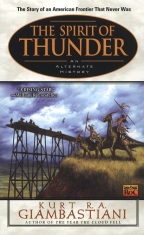The Spirit of Thunder
Kurt R A Giambastiani
ROC / Penguin Putnam
US Mass Market Paperback
ISBN 0-451-45870-2
Publication Date: March, 15 2002
Pages: 350; Price: $6.99
Date Reviewed: 16-06-03
Reviewed by: Katie Dean © 2003

REFERENCES
COLUMNS
|
|
|
The Spirit of ThunderKurt R A GiambastianiROC / Penguin PutnamUS Mass Market PaperbackISBN 0-451-45870-2Publication Date: March, 15 2002Pages: 350; Price: $6.99Date Reviewed: 16-06-03Reviewed by: Katie Dean © 2003 |
|
|
REFERENCES |
COLUMNS |
Anyone who has ever taken an interest in historical events has probably, at some time, wondered "What if?" 'The Spirit of Thunder' (Kurt R A Giambastiani) is an attempt to answer one of the big "What ifs?" of American history. What if some of the Native tribes had succeeded in fending off the white settlers? What if the Frontier had been a true, defensible border between Native and Settler lands rather than a notional line beyond which white settlers had not yet passed? This novel is not, however, an accurate reworking of history, but rather a trip into fantasy. It is well written and tells a good story, but in the end remains an unremarkable piece of fiction.
In essence this novel is about the conflict between two groups who are unable to understand each other. It can be read as an attempt to address the collective guilt of an American nation that finally recognizes and regrets the destruction of a valuable culture. Giambastiani provides a sympathetic picture of Cheyenne life with which it is east to empathize. In so doing, he manages to convey the fundamental differences between the Cheyenne and Western cultures. The Cheyenne possess a deep respect for nature and take from the land only that which they need. They live nomadic lives and aim to leave little or no evidence of their presence upon the land. The Settlers view their natural surroundings as something to be tamed and made to cater to their needs. They ensure that physical objects are placed on their lands as a sign that they have conquered the area. To the Settlers it appears that the Cheyenne are incapable of taming nature and are forced to live a primitive way of life. They cannot understand that the Cheyenne have made a choice based on their beliefs and respect. To the Cheyenne, the Settlers appear destructive and too shortsighted to understand that their 'taming' of nature is not conducive to long term survival. This conflict is portrayed well, but the novel remains unsatisfying in its failure to attempt a resolution of the problem. To explore this particular "What if?" fully would require proper dialogue between the sides in an attempt to allow two cultures to live side by side maintaining peaceable differences. This problem remains as relevant today as it was two centuries back.
The scenes are well set and the story is sufficiently real to keep the reader's interest. However, it lacks the dramatic tension to make the book a real 'page turner'. The characters also tend to appear more as stereotypes rather than well-rounded people. The central character, George Custer, embodies the central theme of the struggle between two distinct cultures trying to find common ground. However, his personal struggle to choose between the Cheyenne way of life and that which he has always known often takes second place to the progress of the story. Giambastiani has a tendency to throw in gratuitous elements that place the novel more in the fantasy genre, but are not necessary to the plot. For example, the Cheyenne ride on giant lizard like creatures called Walkers and Whistlers. References to the Gold Rush and the age of the Railroad are thrown in by the author but never fully developed. Thus the novel remains suspended somewhere between pure fantasy and fictional history.
'The Spirit of Thunder' presents an interesting idea in an unusual fashion. Its central theme is highly relevant and at times the author tries to convey a very important message. Unfortunately, it is never developed as powerfully as it could be and is often disguised by the author's attempt to create a fantasy novel. This novel sadly may not live up to the expectations it sets for itself, but it remains an enjoyable read.